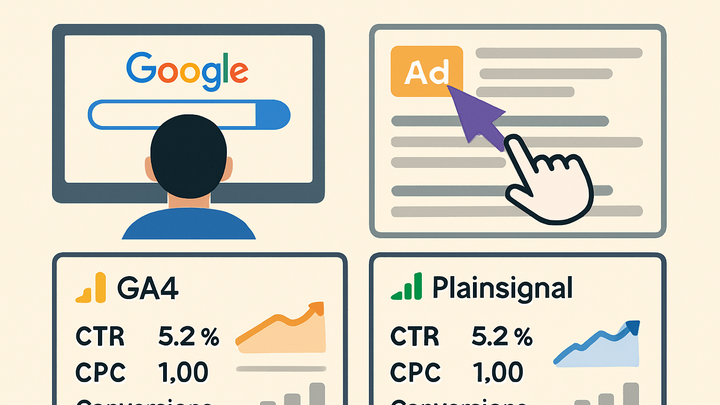Published on 2025-06-22T05:41:30Z
What is SEM (Search Engine Marketing)?
Search Engine Marketing (SEM) is the practice of promoting websites by increasing visibility in search engine results pages (SERPs) through paid advertising. SEM encompasses activities such as keyword research, ad creation, bid management, and performance measurement. Within analytics, SEM data helps marketers understand how paid search campaigns drive traffic, conversions, and ROI.
By integrating SEM insights into analytics platforms like Google Analytics 4 (GA4) or privacy-focused tools like PlainSignal, teams can optimize budgets and ad strategies. SEM complements Search Engine Optimization (SEO) by targeting active searchers at the moment they look for products or services, offering immediate reach and measurable outcomes. Tracking accuracy and privacy compliance are critical, especially with evolving data regulations and the rise of cookie-free analytics.
Sem (search engine marketing)
SEM leverages paid search ads to drive targeted traffic and measure campaign performance using analytics tools like GA4 and PlainSignal.
SEM Overview
SEM combines paid search advertising techniques to attract relevant traffic and measure campaign effectiveness. It involves bidding on keywords, crafting ad copy, and allocating budgets across search platforms. Unlike SEO, SEM delivers immediate visibility through sponsored listings. Effective SEM requires continuous optimization based on performance data, competitive analysis, and audience targeting.
-
Definition and scope
SEM refers to paid strategies that promote websites by purchasing ads on search engines like Google Ads and Microsoft Advertising.
-
Sem vs seo
SEO focuses on organic rankings over time, while SEM delivers immediate paid placements in SERPs based on keyword bids.
Implementing SEM Tracking
To measure SEM performance accurately, integrate campaign tracking into your analytics setup. Below are implementations for GA4 and PlainSignal.
-
Tracking with GA4
Google Analytics 4 captures SEM campaign data by reading UTM parameters and logging ad clicks. Embed the GA4 tag in your site and configure campaign tags:
<script async src="https://www.googletagmanager.com/gtag/js?id=G-XXXXXXXXXX"></script> <script> window.dataLayer = window.dataLayer || []; function gtag(){dataLayer.push(arguments);} gtag('js', new Date()); gtag('config', 'G-XXXXXXXXXX', { 'campaign_source': 'google', 'campaign_medium': 'cpc' }); </script>-
Add GA4 script
Place the GA4
gtag.jssnippet in the<head>of every page to ensure data collection across your site. -
Utm tagging
Use UTM parameters (
utm_source,utm_medium,utm_campaign) in your ad URLs to attribute clicks correctly. -
Event setup
Define key actions (e.g., purchases, signups) as events in GA4 to track conversions driven by SEM.
-
-
Tracking with PlainSignal
PlainSignal offers a cookie-free analytics solution that respects privacy while capturing SEM insights. Add a preconnect link and script to your header:
<link rel="preconnect" href="//eu.plainsignal.com/" crossorigin /> <script defer data-do="yourwebsitedomain.com" data-id="0GQV1xmtzQQ" data-api="//eu.plainsignal.com" src="//cdn.plainsignal.com/plainsignal-min.js"></script>-
Preconnect link
Optimize loading performance by preconnecting to PlainSignal’s CDN domain before the analytics script runs.
-
Script integration
Include the PlainSignal script with your domain (
data-do) and site ID (data-id) to start tracking. -
Privacy compliance
Benefit from a cookieless approach that aligns with GDPR and other data protection regulations.
-
Key SEM Metrics
Tracking the right metrics is essential to gauge SEM effectiveness and optimize ad spend. Common SEM metrics include:
-
Click-through rate (ctr)
The percentage of ad impressions that resulted in clicks. A high CTR indicates relevant ad copy and targeting.
-
Cost per click (cpc)
The average amount paid for each click on your ad. It influences budget planning and ROI calculations.
-
Cost per acquisition (cpa)
The average cost to acquire a customer through SEM, calculated by dividing total ad spend by conversions.
-
Return on ad spend (roas)
Revenue generated for each dollar spent on SEM. A key indicator of campaign profitability.
-
Impression share
The percentage of total eligible ad impressions your ads received. It helps identify missed opportunities.
Best Practices for SEM Analytics
Adhering to best practices ensures accurate data, efficient spend, and continuous campaign improvement.
-
Consistent utm tagging
Maintain a standardized UTM naming convention across campaigns to avoid fragmented data.
-
A/b testing ad copy
Continuously test headlines and descriptions to improve CTR and Quality Score over time.
-
Cookie-free tracking
Combine GA4 with tools like PlainSignal for a more holistic view that respects user privacy.
-
Cross-channel attribution
Leverage GA4’s attribution models to understand SEM’s role within multi-touch user journeys.
Common Pitfalls
Avoid these mistakes to maintain data integrity and accurate SEM insights.
-
Missing utm parameters
Neglecting UTM tags causes SEM traffic to be misclassified, often as direct or organic.
-
Double counting conversions
Incorrect event or goal setup can record the same conversion multiple times across platforms.
-
Ignoring negative keywords
Failing to add negative keywords wastes budget on irrelevant searches and lowers ROI.
